PONTIAC GRAND PRIX History
Introduction: Introduced
in 1962, the Pontiac Grand Prix was one of the first and most popular personal
cars of the 1960s. It was also first in a long line of posh Pontiacs that
continue till today. Of course, luxury in the 60's meant performance, and
the Grand Prix had lots of it.
1962 Pontiac Grand
Prix
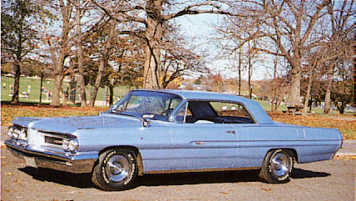 Comments:
The Pontiac Grand Prix was introduced in 1962 as a single hardtop model,
based on the 120 inch wheelbase Catalina platform, Pontiac's shorter big-car
chassis. The new Grand Prix sported straight lined styling along with the
buckets and console interior popular at the time. The Grand Prix represented
a new way of thinking for exterior design as it was tastefully restrained
and was nearly devoid of bright side trim, save for a lower rocker molding.
Up front, the grille was a fine-mesh design, accented by a racing inspired
"chequered flag" badge. The rear panel treatment was also unique to the
car, with a full-width molding that mimicked the grille design, right down
to the badge. The interior was sporty and luxurious, with features such
as Morrokide-covered bucket seats, console, floor shift, tachometer, and
rear speaker. The Grand Prix also could be fitted with Pontiac's gourgeous
8 lug wheels, and was available with either three or four speed manual
transmission or automatic. Comments:
The Pontiac Grand Prix was introduced in 1962 as a single hardtop model,
based on the 120 inch wheelbase Catalina platform, Pontiac's shorter big-car
chassis. The new Grand Prix sported straight lined styling along with the
buckets and console interior popular at the time. The Grand Prix represented
a new way of thinking for exterior design as it was tastefully restrained
and was nearly devoid of bright side trim, save for a lower rocker molding.
Up front, the grille was a fine-mesh design, accented by a racing inspired
"chequered flag" badge. The rear panel treatment was also unique to the
car, with a full-width molding that mimicked the grille design, right down
to the badge. The interior was sporty and luxurious, with features such
as Morrokide-covered bucket seats, console, floor shift, tachometer, and
rear speaker. The Grand Prix also could be fitted with Pontiac's gourgeous
8 lug wheels, and was available with either three or four speed manual
transmission or automatic.
The standard engine was
a 389 cid V8 4 barrel rated at 303 bhp. Economy minded buyers (what were
they thinking?) could substitute a low compression 389 2 barrel rated at
just 230 bhp which was only teamed up with the automatic transmission.
Those buyers wanting more power could order the "regular" 389 Tri-power
with three two barrel carbs rated at 318 bhp with 10.75:1 compression.
Those wanting even more power ordered the 425-A Trophy V8 engines, which
differed from lesser 389s by their four-bolt main caps,lower block reinforcing
ribs, and longer duration cam. The single four barrel was rated at 333
bhp while the Tri-Power version carried a 348 bhp rating. For the truly
obssessed, 16 Grand Prixs were built with Pontiac's 421 Super Duty engines,
rated at a staggering 370 bhp. Only one is known to survive today. Also,
a rumored 75 cars were built with non-Super Duty 421 engines rated at 320
bhp.
Production: 30,195
Engines: 389 V8 (2
bbl) 230 bhp. 389 V8 (4 bbl) 303 bhp. 389 V8 (3x2 bbl) 318 bhp @ 4600 rpm.
389 V8 Trophy (4 bbl) 333 bhp. 389 V8 Trophy (3x2 bbl) 348 bhp. 421 V8
(4 bbl) 320 bhp. 421 V8 Super Duty (3x2 bbl) 370 bhp.
Performance: 389/370:
0-60 mph in 6.6 seconds, 1/4 mile in 15.1 seconds
1963 Pontiac Grand
Prix
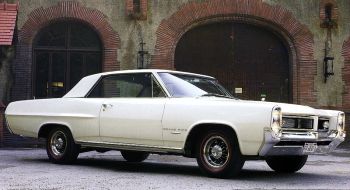 Comments:
The Grand Prix underwent a few changes in its second year. The styling
was all new, with more flowing fender contours and a "Coke bottle" shape.
The sides of the car were clean except for "Grand Prix" lettering, plus
moldings for the rocker panels and wheel openings. The roof was unique
for this year, and featured gracefully sculpted C-pillars which housed
an interesting concave rear window exclusive to the GP in the Pontiac lineup
(although it was shared with the Oldsmobile Starfire). The concave rear
window would become a GP trademark through 1968. The Grand Prix also sported
a special grille treatment with radical stacked headlights and a tail panel
with a special full width molding that covered the rear of the decklid
and also concealed the taillights. Gone were the '62's side cove and chrome
fender wind-splits. To help differentiate it from the Catalina, the Grand
Prix featured round signal lights set off with a single horizontal chrome
strip within the grille cavity. Comments:
The Grand Prix underwent a few changes in its second year. The styling
was all new, with more flowing fender contours and a "Coke bottle" shape.
The sides of the car were clean except for "Grand Prix" lettering, plus
moldings for the rocker panels and wheel openings. The roof was unique
for this year, and featured gracefully sculpted C-pillars which housed
an interesting concave rear window exclusive to the GP in the Pontiac lineup
(although it was shared with the Oldsmobile Starfire). The concave rear
window would become a GP trademark through 1968. The Grand Prix also sported
a special grille treatment with radical stacked headlights and a tail panel
with a special full width molding that covered the rear of the decklid
and also concealed the taillights. Gone were the '62's side cove and chrome
fender wind-splits. To help differentiate it from the Catalina, the Grand
Prix featured round signal lights set off with a single horizontal chrome
strip within the grille cavity.
The standard 389 with 303
bhp and the low compression 389 with 230 bhp carried over for 1963 but
the big news was the deletion of the two 389-425 A Trophy engines. In their
place were two regular production 421 cid V8s. The first featured a single
four barrel carb and 10.75:1 compression and was rated at 353 bhp. The
top street engine was the 421 HO Tri-Power which was rated at a whopping
370 bhp. Three Grand Prixs were actually built with 421 Super Duty engines,
one with the 421 Super Duty 390 bhp NASCAR four barrel engine and two with
the 421 Super Duty 405 bhp dual quad carb engine and aluminum front ends.
None are known to exist today. Overall, buyers loved the new Grand Prix
and sales more than doubled from the year before.
Production: 72,959
Engines: 389 V8 (2
bbl) 230 bhp. 389 V8 (4 bbl) 303 bhp. 389 V8 (3x2 bbl) 318 bhp @ 4600 rpm.
421 V8 (4 bbl) 353 bhp @ 5000 rpm, 455 lb-ft @ 3400 rpm. 421 V8 HO (3x2
bbl) 370 bhp @ 5200 rpm, 460 lb-ft @ 3800 rpm. 421 V8 SD (4 bbl) 390 bhp.
421 V8 SD (2x4 bbl) 405 bhp.
Performance: 421/370:
0-60 in 6.6 seconds, 1/4 mile in 15.1 seconds @ 94 mph.
1964 Pontiac Grand
Prix
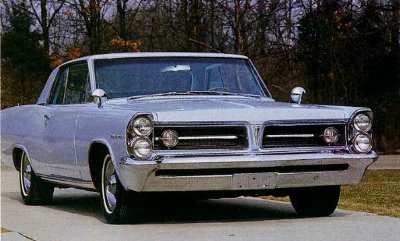 Comments:
The Grand Prix sported only a mild redesign from the previous year. The
headlights were frenched into the fender and bumper, instead of cutting
sharply into the body like the year before. The grille treatment was also
updated, with a fine horizontal slat arrangement. The turn signals remained
in the grille cavity, but were now rectangular with rounded corners. The
large chrome support bars were deleted. The base 389 increased to 306 bhp
when mated to the manual transmission (but still 303 bhp with automatic).
The economy 389 carried over. With the GM pullout from racing in January
1963, the Super Duty engines were officially killed. This did free up the
Pontiac engineers to focus their efforts on the street engines. The 389
Tri-Power was now rated at 330 bhp (up from 318). The 421 4 barrel engine
had a slightly lower compression ratio, and horsepower fell from 353 bhp
to 320 bhp. The 421 Tri-Power could now be ordered in two forms. The first
featured the standard camshaft and exhaust manifolds and was rated at 350
bhp. The top engine was the famous 421 HO, which was good for 370 bhp. Comments:
The Grand Prix sported only a mild redesign from the previous year. The
headlights were frenched into the fender and bumper, instead of cutting
sharply into the body like the year before. The grille treatment was also
updated, with a fine horizontal slat arrangement. The turn signals remained
in the grille cavity, but were now rectangular with rounded corners. The
large chrome support bars were deleted. The base 389 increased to 306 bhp
when mated to the manual transmission (but still 303 bhp with automatic).
The economy 389 carried over. With the GM pullout from racing in January
1963, the Super Duty engines were officially killed. This did free up the
Pontiac engineers to focus their efforts on the street engines. The 389
Tri-Power was now rated at 330 bhp (up from 318). The 421 4 barrel engine
had a slightly lower compression ratio, and horsepower fell from 353 bhp
to 320 bhp. The 421 Tri-Power could now be ordered in two forms. The first
featured the standard camshaft and exhaust manifolds and was rated at 350
bhp. The top engine was the famous 421 HO, which was good for 370 bhp.
Production: 63,810
Engines: 389 V8 (2
bbl) 230 bhp. 389 V8 (4 bbl) 303 bhp. 389 V8 (3x2 bbl) 330 bhp @ 4600 rpm,
430 lb-ft @ 3200 rpm. 421 V8 (4 bbl) 320 bhp @ 4400 rpm, 455 lb-ft @ 2800
rpm. 421 V8 (3x2 bbl) 350 bhp 421 V8 HO (3x2 bbl) 370 bhp @ 5200 rpm, 460
lb-ft @ 3800 rpm
1965 Pontiac Grand
Prix
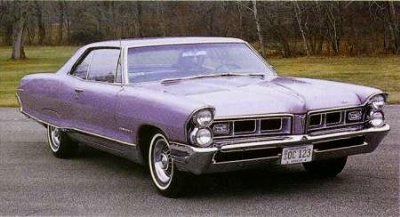 Comments:
The second generation Grand Prix was still built on the shorter Catalina
platform, but was larger and weighter than the 1962-1964 original. The
Grand Prix was increasingly being shifted away from performance and more
towards luxury, and with the same flowing "coke bottle" styling featured
on all fullsize Pontiacs during this time and standard standard fender
skirts, the Grand Prix looked as big as the Bonneville sedan. A bench seat
could be ordered for the first time in place of the buckets and console.
But the Grand Prix maintained tradition with a somewhat more formal roofline
than Catalina two-door hardtops, complete with a concave backlight just
like the 1962-1964 models. Comments:
The second generation Grand Prix was still built on the shorter Catalina
platform, but was larger and weighter than the 1962-1964 original. The
Grand Prix was increasingly being shifted away from performance and more
towards luxury, and with the same flowing "coke bottle" styling featured
on all fullsize Pontiacs during this time and standard standard fender
skirts, the Grand Prix looked as big as the Bonneville sedan. A bench seat
could be ordered for the first time in place of the buckets and console.
But the Grand Prix maintained tradition with a somewhat more formal roofline
than Catalina two-door hardtops, complete with a concave backlight just
like the 1962-1964 models.
A lot changed in the powertrain
department. Power increased across the board, primarily due to new cylinder
head designs, which also changed the intake manifold bolt pattern. The
standard engine was the 389 4 barrel which was rated at 333 bhp with the
manual and 325 bhp with the automatic transmission. The automatic transmission
version used the milder 066 cam while the manual version used the hotter
067 cam. Compression was 10.5:1 for both engines. The low-compression 389
was now rated at 256 bhp and the optional 389 Tri Power increased to 338
bhp. The 421 engines also were improved. The 421 4 barrel put out 338 bhp,
while the two Tri-Power versions put out 353 bhp and 376 bhp. The biggest
change was the new M40 Turbo-Hydramatic 400 automatic transmission, which
replaced the old "Slim Jim" 2 speed Hydramatic. The new automatic was a
tremendous improvement over the old one and only 1,973 manual GPs were
sold.
Production: 58,881
Engines: 389 V8 (2
bbl) 256 bhp. 389 V8 (4 bbl) 325/333 bhp. 389 V8 (3x2 bbl) 338 bhp. 421
V8 (4 bbl) 338 bhp. 421 V8 (3x2 bbl) 353 bhp. 421 V8 (3x2 bbl) 376 bhp.
1966 Pontiac Grand
Prix
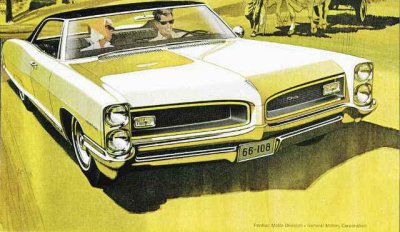 Comments:
The Grand Prix was slightly restyled for 1966. Frenched headlights replaced
the previous year's chrome "eyebrows." The front end sported blacked-out
plastic eggcrate grilles and turn signals in the same cavities, which curved
toward the sharp, pointed nose; similar to the 1966 GTO. The GP's taillight
panel featured chrome trim ribs, blacked out in between to give the impression
of full-width taillights, although the lights were conventional in size
and were hidden between the ribs at the ends. The engine line up remained
the same, except for the deletion of the 338 bhp 389 Tri Power engine.
Pontiac probably figured out that it was a bit silly to have two engines
with the same power rating and thus just kept the bigger and simpler of
the two. This would be the last year for Pontiac's Tri-Power engines. Sales
continue to decline, with only 917 GPs sold with manual transmissions. Comments:
The Grand Prix was slightly restyled for 1966. Frenched headlights replaced
the previous year's chrome "eyebrows." The front end sported blacked-out
plastic eggcrate grilles and turn signals in the same cavities, which curved
toward the sharp, pointed nose; similar to the 1966 GTO. The GP's taillight
panel featured chrome trim ribs, blacked out in between to give the impression
of full-width taillights, although the lights were conventional in size
and were hidden between the ribs at the ends. The engine line up remained
the same, except for the deletion of the 338 bhp 389 Tri Power engine.
Pontiac probably figured out that it was a bit silly to have two engines
with the same power rating and thus just kept the bigger and simpler of
the two. This would be the last year for Pontiac's Tri-Power engines. Sales
continue to decline, with only 917 GPs sold with manual transmissions.
Production: 36,757
Engines: 389 V8 (2
bbl) 256 bhp. 389 V8 (4 bbl) 325/333 bhp. 421 V8 (4 bbl) 338 bhp. 421 V8
(3x2 bbl) 353 bhp. 421 V8 (3x2 bbl) 376 bhp.
1967 Pontiac Grand
Prix
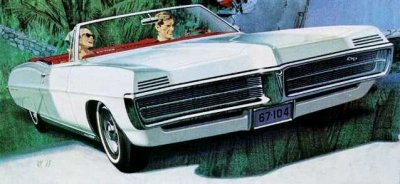 Comments:
The Pontiac Grand Prix was restyled again for 1967, its third generation.
The new restyling was bigger and more massive-looking than ever before,
despite remaining on an unchanged wheelbase. The front end was all new
and although the same bumper was used on the Catalina, the Grand Prix's
housed both disappearing headlights and headlight doors with an integrated
grille, instead of having the stacked headlights like the Catalina. In
the place where the top headlight would have been was a louvered front
fender extension panel. The parking lamps were secreted in the fender tips,
behind three small, horizontal slots. Also new were hidden windshield wipers.
The hardtop coupe had new one-piece side glass, with GP initials frosted
on it. Twin pinstripes decorated the fender tops. A wasp-waist rear emphasized
width. The taillamps were embedded inside twin slots on the slanted rear
end panel. Identification items included GP initials on the left-hand grille
and right hand edge of the rear deck lid, plus the Grand Prix name spelled
out on the rear fenders. The big news was the introduction of a Grand Prix
convertible model, the only year it would be offered. Comments:
The Pontiac Grand Prix was restyled again for 1967, its third generation.
The new restyling was bigger and more massive-looking than ever before,
despite remaining on an unchanged wheelbase. The front end was all new
and although the same bumper was used on the Catalina, the Grand Prix's
housed both disappearing headlights and headlight doors with an integrated
grille, instead of having the stacked headlights like the Catalina. In
the place where the top headlight would have been was a louvered front
fender extension panel. The parking lamps were secreted in the fender tips,
behind three small, horizontal slots. Also new were hidden windshield wipers.
The hardtop coupe had new one-piece side glass, with GP initials frosted
on it. Twin pinstripes decorated the fender tops. A wasp-waist rear emphasized
width. The taillamps were embedded inside twin slots on the slanted rear
end panel. Identification items included GP initials on the left-hand grille
and right hand edge of the rear deck lid, plus the Grand Prix name spelled
out on the rear fenders. The big news was the introduction of a Grand Prix
convertible model, the only year it would be offered.
Both the 389 and 421 engines
received a bore increase to 4.12 inches, which resulted in new engine displacements
of 400 and 428 cid. In addition, the block received new cylinder heads
with completely redesigned ports. Valve diameters were increased to 2.11
inches for intakes and 1.77 inches for exhaust. To make room for the increased
valve sizes, the distance between the valve stem centers was increased
from 1.82 to 1.98 inches. The new heads were said to increase airflow from
30 to 35 percent and were superiour to any previous design -- even that
of the Super Dutys. Since GM outlawed all triple carb setups (except on
the Corvette), Pontiac used a spread bore Rochester Quadrajet 4 barrel
carb. The new setup and enlarged engines were actually equal in performance
to the old Tri-Power engines and were easier to tune and maintain. Furthermore,
they meet the first federal smog standards that took place in 1967. The
base engine was now a 400 cid V8 with 10.5:1 compression that was rated
at 350 bhp. A low compression 400 cid V8 265 bhp economy engine could be
substituted at no cost. A new 428 cid V8 with 360 bhp was available, with
a Quadra Power 428 option with 376 bhp. Transmissions included the column
shifted three-speed manual, three-speed manual with floor shift, four speed
manual with floor shift, and the Turbo Hydramatic automatic transmission.
Interiors came standard with soft countered bucket seats of expanded Morrokide,
a cloth option for Sports Coupes. The Strato-bench seat was a no-cost substitute
for hardtop models. Woodgrain interior trim was now simulated elm burl,
rather than real walnut veneers. Most color combinations were monochromatic,
but darker carpets were used when extremely light colored seats were ordered.
First-phase federal safety equipment also made their first appearance.
New technical advances included a dual master cylinder, optional disc brakes,
collapsible steering column, and side marker lights. Unfortunately, sales
continued to decline as performance buyers turned to smaller cars.
Production: Hardtop
Coupe: 37,125. Convertible: 5,856
Engines: 400 V8 265
bhp. 400 V8 350 bhp. 428 V8 360 bhp. 428 V8 376 bhp.
1968 Pontiac Grand
Prix
Comments: The Pontiac
Grand Prix was redesigned again for 1968, but it looked even heavier looking,
which further hurt sales. The Grand Prix now had a new peripheral front
bumper and a massive pointed nose dividing a split, cross-hatched grille.
It had hidden headlamps and a GP badge on the left hand side. The parking
lights were now exposed at the corners of the gravel pan. At the rear,
large horizontal taillamps were house inside the bumper and were no longer
hidden behind the grilles or slats. The rear side window lost its sharp
trailing edge, a Grand Prix signature design. New wheel discs and pencil-thin
whitewall tires were introduced. The rocker panel had a 428 engine call
out. Standard equipment included all GM safety features, Deluxe wheel discs,
fender skirts, dual exhausts, padded Morrokide bucket seats with contoured
backs and armrests, center console, three speed manual transmission with
floor shift and a 400 cid V8. The Strato bench seat and cloth upholstery
could be substituted. Also available was a "halo style" Cordova vinyl top
that unfortunately looked a bit awkward as it tended to exaggerate the
lower half's size even more than before. As for the powertrain, the two
400 cid engines were carried over, but the two 428 engines were improved.
Four speed manual transmissions were limited to 428 cid engine vehicles.
This would be last year that the Grand Prix would be based on the B-body.
Production: 31,711
Engines: 400 V8 265
bhp. 400 V8 350 bhp. 428 V8 360 bhp. 428 V8 376 bhp. 428 V8 HO 390 bhp.
1969 Pontiac Grand
Prix
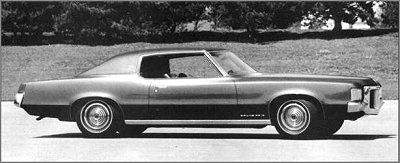 Comments:
The Grand Prix began its four generation on a whole new platform, moving
from the Catalina's 121 inch wheelbase to a new "A-special" platform with
an exclusive 118 inch wheelbase which was later named the G-body. The new
redesign was a combination of modern elegance, and distinct Pontiac styling
cues. It featured a "beaked" radiator" style grille, "Coke bottle" sides
and slotted taillights and resembled something that Dusenberg would have
offered if they were still in business. Pontiac product planners saw (or
exploited) the similarity and offered the Grand Prix only as a hardtop
coupe, and in two trims, J and SJ (a la Duesenberg). The SJ cost 6 more
than the J model and offered more luxury and usually more standard power.
New for 1969 was an innovative curved cockpit dash design, and was dubbed
the "Command Seat." The buying public loved the redesign and the GP's better
handling, which was much better than any previous Grand Prix since the
1962 original (which was similar in size). The sales success of the 1969
Grand Prix prompted Chevrolet to offer the similar Monte Carlo in 1970,
which cut into Grand Prix sales. Comments:
The Grand Prix began its four generation on a whole new platform, moving
from the Catalina's 121 inch wheelbase to a new "A-special" platform with
an exclusive 118 inch wheelbase which was later named the G-body. The new
redesign was a combination of modern elegance, and distinct Pontiac styling
cues. It featured a "beaked" radiator" style grille, "Coke bottle" sides
and slotted taillights and resembled something that Dusenberg would have
offered if they were still in business. Pontiac product planners saw (or
exploited) the similarity and offered the Grand Prix only as a hardtop
coupe, and in two trims, J and SJ (a la Duesenberg). The SJ cost 6 more
than the J model and offered more luxury and usually more standard power.
New for 1969 was an innovative curved cockpit dash design, and was dubbed
the "Command Seat." The buying public loved the redesign and the GP's better
handling, which was much better than any previous Grand Prix since the
1962 original (which was similar in size). The sales success of the 1969
Grand Prix prompted Chevrolet to offer the similar Monte Carlo in 1970,
which cut into Grand Prix sales.
Production: 112,486
Engines: 400 V8 265
bhp. 400 V8 350 bhp. 428 V8 360 bhp. 428 V8 370 bhp. 428 V8 HO 390 bhp.
Performance: 428/390:
1/4 mile in 14.1 seconds
1970 Pontiac Grand
Prix
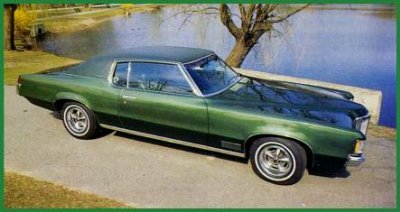 Comments:
The 1970 model was essentially a carryover from the previous year except
that the grille itself now featured vertical slats, and vertical hash marks
appeared on the front fenders just behind the front wheels. New interior
upholstery patterns and the reintroduction of the bench seat rounded out
the visual changes. Under the hood, the two 400 cid V8s carried over. But
the big news was that both 428 engines were dropped and in there place
was Pontiac's brand new 455 cid V8, the largest engine ever in a Grand
Prix. The 455 cid V8 had a four barrel carb and was rated at 370 bhp and
a staggering 500 lb-ft of torque. Comments:
The 1970 model was essentially a carryover from the previous year except
that the grille itself now featured vertical slats, and vertical hash marks
appeared on the front fenders just behind the front wheels. New interior
upholstery patterns and the reintroduction of the bench seat rounded out
the visual changes. Under the hood, the two 400 cid V8s carried over. But
the big news was that both 428 engines were dropped and in there place
was Pontiac's brand new 455 cid V8, the largest engine ever in a Grand
Prix. The 455 cid V8 had a four barrel carb and was rated at 370 bhp and
a staggering 500 lb-ft of torque.
Also new for 1970 was a
special Hurst SSJ version, a semi-custom conversion with electric sunroof,
gold-colored wheels, and Hurst shifter. The SSJ started life as J models
(the vinyl accent stripes on SJs were incompatible) built by Pontiac, than
sent to Hurst. All 272 cars were painted either Cameo white (code CC) or
Starlight Black (code AA). Interiors were ivory, black, or sandlewood in
cloth or all-Morrokide. Mandatory options included body-color Sport mirrors,
G78 x 14 whitewalls and Rally II wheels. The Space-Saver spare and Ride
& Handling package were recommended. After assembly, the cars were
shipped to a Hurst plant in Southfield, Michigan where Frost Gold accents
were applied to the hood, side windows, front of the roof, and Rally II
wheels. A landau-style half-top (Antique white, white, or black) was installed,
as was a steel electronically operated sunroof (similar to that used in
the Cadillac Eldorado.
Production: 65,750
Engines: 400 V8 300
bhp. 400 V8 350 bhp. 455 V8 370 bhp.
1971 Pontiac Grand
Prix
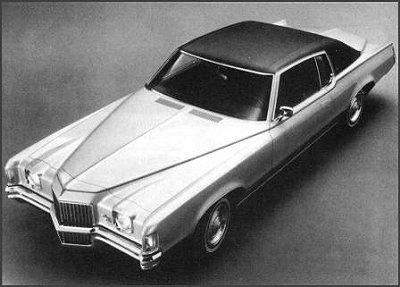 Comments:
The Grand Prix was modestly restyled for 1971 with a crisper, slightly
"boattailed" rear deck. Other styling cues included single headlamps, and
a separate bumper running across the grille. Overall length increased by
two inches. The Hurst SSJ version continued for 1971, although the Rally
II wheels could be replaced by gold honeycomb or American mag wheels. New
Hurst accessories appeared including an Auto-Stick shifter (with automatic
transmission only), A Roll Control device, and a digital computer to calculate
speed and elapsed times in the quarter-mile. Also available where B.F.
Goodrich radial T/A GR60-15 tires in place of the standard G78x14 white
stripes. Engine choices were the base 400 cid V8 with 300 bhp in the J
model and the 455 cid V8 with 325 horsepower that was standard in the SJ
model and optional in the J model. Only 157 Jurst SSJs were sold. Comments:
The Grand Prix was modestly restyled for 1971 with a crisper, slightly
"boattailed" rear deck. Other styling cues included single headlamps, and
a separate bumper running across the grille. Overall length increased by
two inches. The Hurst SSJ version continued for 1971, although the Rally
II wheels could be replaced by gold honeycomb or American mag wheels. New
Hurst accessories appeared including an Auto-Stick shifter (with automatic
transmission only), A Roll Control device, and a digital computer to calculate
speed and elapsed times in the quarter-mile. Also available where B.F.
Goodrich radial T/A GR60-15 tires in place of the standard G78x14 white
stripes. Engine choices were the base 400 cid V8 with 300 bhp in the J
model and the 455 cid V8 with 325 horsepower that was standard in the SJ
model and optional in the J model. Only 157 Jurst SSJs were sold.
Production: 58,325
Engines: 400 V8 300
bhp. 400 V8 350 bhp. 455 V8 325 bhp. 455 V8 370 bhp.
1972 Pontiac Grand
Prix
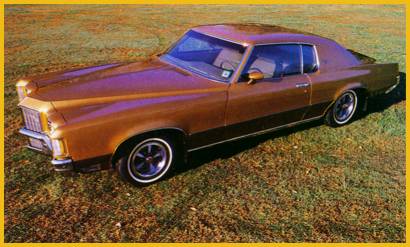 Comments:
GM followed the indstry standard and began to rate all its engines in SAE
net horsepower, which resulted in a significant drop in power ratings,
although true engine power was relatively unchanged. There was new styling
for 1972 which included an eggcrate grille with multiple fins between main
bars, and triple-segment taillamps. Finned wheelcovers were available.
There was also rumored to be 60 Hurst SSJs built, all with a dual-gate
automatic transmission. 1972 would be the last year for the John DeLorean
long hood/short deck design. Comments:
GM followed the indstry standard and began to rate all its engines in SAE
net horsepower, which resulted in a significant drop in power ratings,
although true engine power was relatively unchanged. There was new styling
for 1972 which included an eggcrate grille with multiple fins between main
bars, and triple-segment taillamps. Finned wheelcovers were available.
There was also rumored to be 60 Hurst SSJs built, all with a dual-gate
automatic transmission. 1972 would be the last year for the John DeLorean
long hood/short deck design.
Production: 91,961
Engines: 400 V8 250
bhp (net). 455 V8 300 bhp (net).
1973 Pontiac Grand
Prix
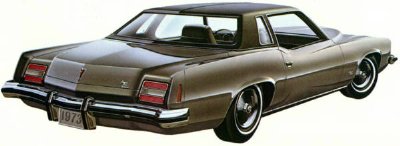 Comments:
The Pontiac Grand Prix was restyled again with a new fixed-pillar "Colonnade"
styling, which had fixed rear opera windows. The front end styling mimicked
the previous generation, with a large vertical slatted grille, headlights
set in square bezels, and turn signals cut into the leading edge of the
front fenders. The slim bumpers were not as massive as the '71-'72 ones,
but jutted ahead of the grille. The rear of the car was similar to previous
years, although the taillights were no longer set in the bumper. The Grand
Prix now shared its chassis with the 116 inch wheelbase Monte Carlo and
all A-body four doors, a decrease of two inches. Overall length actually
increased 3 inches to 216.6" but the real killer was overall weight, which
increased 125 pounds on the base GP, but up to 500 pounds more on a fully
loaded SJ model. Engine choices were limited to a 400 cid 4 barrel V8 rated
at 230 bhp (net) or an optional 455 4 barrel V8 rated at 250 bhp (net).
Although there were rumors that the legendary Super Duty 455 engines would
be offered in the Grand Prix (as well as GTOs), this never happened and
they were only available to the '73-'74 Firebird Formula and Trans Am.
Despite all this, sales actually increased tremendously to 153,899 units.
There was no special Hurst prepared SSJ models. Although the Pontiac Grand
Prix would continue to the present day, 1972 is considered the end of the
performance Grand Prix's. Comments:
The Pontiac Grand Prix was restyled again with a new fixed-pillar "Colonnade"
styling, which had fixed rear opera windows. The front end styling mimicked
the previous generation, with a large vertical slatted grille, headlights
set in square bezels, and turn signals cut into the leading edge of the
front fenders. The slim bumpers were not as massive as the '71-'72 ones,
but jutted ahead of the grille. The rear of the car was similar to previous
years, although the taillights were no longer set in the bumper. The Grand
Prix now shared its chassis with the 116 inch wheelbase Monte Carlo and
all A-body four doors, a decrease of two inches. Overall length actually
increased 3 inches to 216.6" but the real killer was overall weight, which
increased 125 pounds on the base GP, but up to 500 pounds more on a fully
loaded SJ model. Engine choices were limited to a 400 cid 4 barrel V8 rated
at 230 bhp (net) or an optional 455 4 barrel V8 rated at 250 bhp (net).
Although there were rumors that the legendary Super Duty 455 engines would
be offered in the Grand Prix (as well as GTOs), this never happened and
they were only available to the '73-'74 Firebird Formula and Trans Am.
Despite all this, sales actually increased tremendously to 153,899 units.
There was no special Hurst prepared SSJ models. Although the Pontiac Grand
Prix would continue to the present day, 1972 is considered the end of the
performance Grand Prix's.
Production: 153,899
Engines: 400 V8 250
bhp (net). 455 V8 300 bhp (net).
History from: www.musclecarclub.com
Tagasi
|